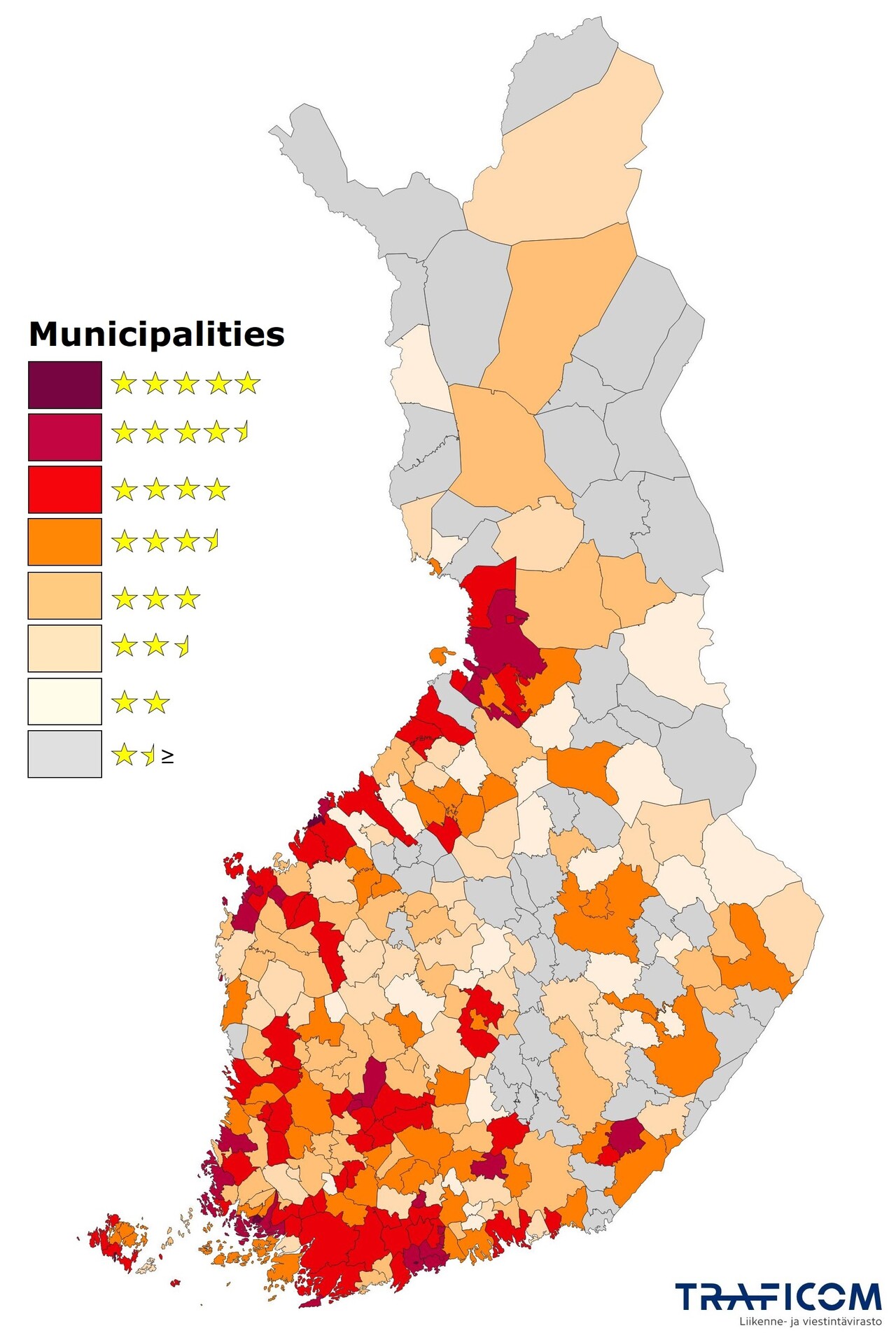The broadband rating carried out by Finnish Transport and Communications Agency Traficom involved examining the availability of fixed broadband connections and the coverage of mobile networks in Finnish municipalities. The number of municipalities that received a rating of at least 4.5 out of 5 stars was 28. The higher star ratings were given to municipalities with larger populations, as both fixed and mobile networks are built where the numbers of users are highest. The number of municipalities that received a rating of less than 2 stars was 56. Traficom’s annual broadband rating is used to measure the availability of digital infrastructure in Finland.
There are major differences between Finnish municipalities when it comes to digital infrastructure and by extension the preconditions of municipalities for adopting various digital solutions. For many consumers, good online connectivity is a major factor when choosing a place to live due to remote working, the digitalisation of agricultural activities or remote hobbies, for example. A reliable and fast internet connection is also essential for many everyday tasks. Digital connections also contribute to how likely people are to stay in a given municipality for decades to come.
Traficom has calculated a star rating for each municipality in Finland based on how developed their fixed and mobile broadband connections are. The highest star rating of five was given to Kauniainen, Maarianhamina, Pietarsaari and Raisio. They are all municipalities covering small areas that offer good connectivity both at home and outside of it. Out of Finland’s most populous cities, Espoo, Helsinki, Lahti, Oulu, Tampere, Turku and Vantaa received a rating of 4.5 stars. The total number of municipalities to receive a rating of at least 4.5 stars was 28.

Examining municipalities based on Statistics Finland’s statistical grouping of municipalities, we can see that urban municipalities fared quite well in the rating, receiving an average rating of 4 stars. Meanwhile, semi-urban municipalities received an average rating of 3 stars, while rural municipalities received an average rating of 2.5 stars. “This shows that networks are primarily built in the most populated areas. In addition to differences between municipalities, there may also be significant differences in broadband availability within municipalities between densely built population centres and more sparsely populated suburbs, for example,” says Senior Specialist Joonas Sotaniemi.

Finland differs from other countries in how mobile and fixed broadband connections are used
“In most other countries, mobile broadband is used primarily outside of the home, with households almost exclusively using fixed broadband for home needs. In Finland, however, just under half of households only use mobile broadband either via a phone or with a 4G/5G modem, for example,” clarifies Senior Specialist Marja Heinonen. According to a consumer survey carried out by Traficom, in municipalities with over 50,000 residents a clear majority of the population uses both a fixed broadband connection and a mobile broadband connection at home. In smaller municipalities, a slight majority of households use mobile broadband only, either by using a phone as a mobile hotspot or with a 4G/5G modem.
The star rating describes the state of the municipality’s digital infrastructure, which provides the foundation for using digital services. There are small differences between residential areas of different sizes in how much various digital online services are used. In municipalities with over 50,000 residents, over half of residents have made internet calls and watched TV series and films online, whereas in smaller municipalities less than half of residents have made internet calls, and in rural municipalities less than half have watched TV series or films online. In the largest municipalities, 44% of residents need a broadband connection at home for work, whereas in municipalities with less than 50,000 residents the corresponding share is only 37% and in rural municipalities 41%.
It should be noted, however, that the use of the aforementioned services may be to some extent reflective of the population structures of different areas and thus not indicative of access to online services. The survey found no differences between areas in how well available broadband connections corresponded to respondents’ needs, as respondents were primarily happy with available connections in all areas.
Background
The star ratings were calculated based on the availability of fixed broadband connections offering download speeds of 30, 100 and 1,000 Mbps, i.e. the percentage of households that had access to fixed broadband connections offering these speeds at the end of last year. As regards mobile broadband, the star ratings are based on the household coverage of networks offering download speeds of 100 and 300 Mbps and the road coverage of networks offering download speeds of 100 Mbps. The download speed of a mobile network corresponds to its maximum speed in ideal conditions.
The data on the availability of fixed broadband and the coverage of mobile broadband services are based on data collected from telecommunications operators by Traficom. The data describe the situation at the end of 2022. The data on the use of services in different areas is based on a consumer survey commissioned by Traficom in autumn 2022 and carried out by IROResearch Oy. The survey consisted of interviews with 2,000 people over the age of 15. In addition to being published, the data is utilised in Traficom’s guidance and supervisory work.
Lisätiedot
Fixed broadband availability in Finland (External link)
Coverage of mobile broadband services in Finland (External link)
Traficom’s map service (External link)
Consumer survey – communications services 2022 (External link)
Statistics Finland’s statistical grouping of municipalities 2023 (External link)
Senior Specialist Joonas Sotaniemi, p. 0295 390 309, joonas.sotaniemi@traficom.fi
Senior Specialist Marja Heinonen, p. 029 534 7355, marja.heinonen@traficom.fi